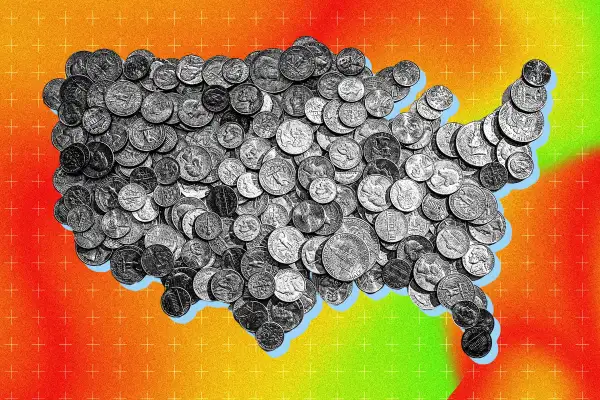The Places With the Highest Credit Scores in the U.S. Might Surprise You

In your financial life, few numbers are as important as the three little digits that make up your credit score. Your ZIP code might just be one of them.
A new study from Opportunity Insights, a Harvard-based research group, concludes that where you grew up “plays a powerful role” in determining your finances and upward mobility later in life — and, in particular, your credit score. The researchers partnered with the U.S. Census Bureau to analyze financial, racial and geographic data on more than 25 million people through 2020.
The takeaway? “Household financial success is certainly related to the local economy,” says Adam Rust, director of financial services at the nonprofit Consumer Federation of America.
To drill down further, Money independently analyzed underlying data from more than 12,000 counties across the nation to determine where Americans have the highest — and lowest — credit scores.
Overall, the average credit score across all counties was 678, which is typically classified as "good" on a scale from 300 to 850. But we found major credit score discrepancies among different regions of the U.S., ranging from 769 ("very good") to as low as 580 (right on the edge of "fair" and "poor").
Here’s a closer look at the findings.
Which counties have the highest credit scores?
Among the counties with the highest credit scores, one trend immediately sticks out: North Dakota dominates the list. Of the 10 counties with the highest average credit scores, six are in North Dakota, and all of them are in the northern Midwest.
Average Credit Score | Percent of Residents Delinquent on Bill in Last 4 Years | |
|---|---|---|
1. Slope, North Dakota | 769 | 11.5% |
2. Lamoure, North Dakota | 769 | 16.4% |
3. Hettinger, North Dakota | 768 | 17.9% |
4. Sheridan, North Dakota | 767 | 22.3% |
5. Rock, Nebraska | 767 | 18.7% |
6. Logan, North Dakota | 766 | 13.9% |
7. Hayes, Nebraska | 765 | 20.1% |
8. Campbell, South Dakota | 765 | 17.4% |
9. Faulk, South Dakota | 765 | 19.4% |
10. Emmons, North Dakota | 765 | 16.2% |
On a personal level, your on-time payment history is the single most important factor in determining your credit score. And North Dakotans are among the least likely to be 90 days or more late with their debt payments. Residents of the Peace Garden State's Slope and Logan counties, for instance, have the two lowest delinquency rates in the U.S.
Rust notes that unemployment rates are also closely tied to credit, as folks typically need income — usually from a job — to be able to pay their bills on time.
“Unemployment in places like the Dakotas is among the lowest in the country,” he says, due in large part to ample jobs in energy production, manufacturing and agriculture.
According to the U.S. Department of Labor, South Dakota had an unemployment rate of 1.8% in June, the lowest in the country. North Dakota had the second-lowest unemployment rate, at 2.5%. For context, the national unemployment rate last month was 4.1%.
Which counties have the lowest credit scores?
Most of the counties with the lowest credit scores were clustered in Southeastern states.
Average Credit Score | Percent of Residents Delinquent on Bill in Last 4 Years | |
|---|---|---|
1. Terrell, Georgia | 580 | 72.3% |
2. East Carroll, Louisiana | 582 | 77.2% |
3. Shannon, South Dakota | 582 | 56.7% |
4. Allendale, South Carolina | 583 | 75.8% |
5. Tunica, Mississippi | 585 | 70.5% |
6. Claiborne, Mississippi | 587 | 73.8% |
7. Todd, South Dakota | 588 | 63.6% |
8. Sunflower, Mississippi | 588 | 68.7% |
9. Lee, South Carolina | 589 | 71.9% |
10. Madison, Louisiana | 590 | 73% |
The Southeast’s performance came as no surprise to Rust, who says the region has historically struggled with deep financial and racial inequalities.
“You've got persistent poverty, you've got inequality in wealth, you've got differences in employment rates. All of those reinforce each other over time,” Rust says. “It's not surprising there would be a similar pattern observing credit scores.”
South Dakota is the only state that shows up on the lists of top 10 highest and lowest credit scores.
It's important to acknowledge the racial and ethnic inequities at play here, too. While both Dakotas are made up of about 80% white residents, the states are home to roughly 100,000 Native Americans. These groups tend to be very segregated, with large populations of Native Americans living on reservations and below the poverty line due to lack of access to financial resources and economic opportunities, leading to wide disparities between counties.
Faulk, South Dakota, the state’s highest-rated county in terms of credit scores with an average of 765, is extremely homogeneous — about 96% white. Shannon County, on the other hand, is almost an exact inverse. Located entirely within the Pine Ridge Indian Reservation, it's home to 97% Native American residents and has an average credit score of 582.
More from Money:
Buy Now, Pay Later Loans Can Now Affect Your Credit Score
Your Credit Report Just Got Easier to Understand
This Secret Web of Credit Reports Is Tracking Everything You Do

